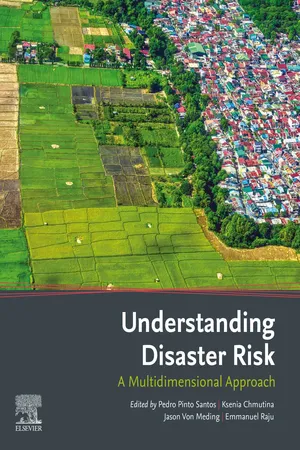
Understanding Disaster Risk
A Multidimensional Approach
- 370 pages
- English
- ePUB (mobile friendly)
- Available on iOS & Android
Understanding Disaster Risk
A Multidimensional Approach
About This Book
Understanding Disaster Risk: A Multidimensional Approach presents the first principle from the UNISDR Sendai Framework for Disaster Risk Reduction, 2015-2030. The framework includes a discussion of risk and resilience from both a theoretical and governance perspective in light of ideas that are shaping our common future. In addition, it presents innovative tools and best practices in reducing risk and building resilience. Combining the applications of social, financial, technological, design, engineering and nature-based approaches, the volume addresses rising global priorities and focuses on strengthening the global understanding of vulnerability, displaced communities, cultural heritages and cultural identity.
Readers will gain a multifaceted understanding of disaster, addressing both historic and contemporary issues. Focusing on the various dimensions of disaster risk, the book details natural and social components of risk and the challenges posed to risk assessment models under the climate change paradigm.
- Addresses the current challenges in policy and practice for building resilience strategies
- Follows the global frameworks for disaster risk reduction and sustainability, specifically the UNISDR Sendai Framework for DRR, 2015-2030
- Aids in understanding the natural and social components of risk in a diverse and globalized world
- Presents the challenges posed to risk assessment models under the climate change paradigm
Frequently asked questions
Information
Chapter 0.1: Resilience in the Anthropocene
b Copernicus Institute of Sustainable Development, Utrecht University, Utrecht, The Netherlands
c Department Architecture and Design, Politecnico di Torino, Turin, Italy
Abstract
Keywords
0.1.1: Introduction
0.1.2: Methodology
Table of contents
- Cover image
- Title page
- Table of Contents
- Copyright
- Contributors
- Preface
- Chapter 0.1: Resilience in the Anthropocene
- Section 1: Risk Assessment
- Section 2: Prevention
- Section 3: Mitigation
- Section 4: Preparedness
- Section 5: Response
- Index